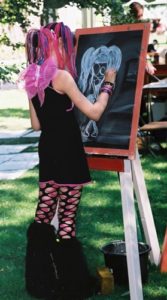Anita Corbin’s recent and retrospective exhibition Visible Girls: Revisited came into my life recently as a clipping from a newspaper, sent from Spain by my mum. The project is close to my heart, as when I am not involved in Girl Museum projects I research music scenes in the UK and Spain, and plan my own exhibition with a friend, who just so happens to be a wonderful photographer in the Birmingham punk scene. As I progress with my research, the invisibility of girls in style and music based subcultures becomes more and more obvious, absent from the academic texts that I am reading and a rarity in the music-based exhibitions and research that I have recently been involved.
Since the moral panics of the 1960s and 70s, newspapers condemning the insatiable and uncontrollable youth of the postwar period, the engagement of girls in subcultures has been overlooked in terms of academic research and in the media. Writers such as Angela McRobbie (now an influential feminist researcher) suggested that this invisibility was due to the realities of being a girl in the 1970s, expected to socialize at home and under the watchful eyes of parents, terrified of the social stigma of pregnancy before marriage. However, while ideas on sex before marriage and girls in public spaces have changed, media representations of alterative music scenes continue to be dominated by men, the pop mainstream instead associated with the feminine fan.
In the early 1980s, Anita Corbin, a student photographer in London, was equally aware of the underrepresentation of women in subcultural settings and began to photograph young women in pubs and clubs. While she was at first interested in the colourful appearance of these girls, she began to identify and understand the close nature of the relationships between women and the subversive role that being part of a subculture offered women, defying expectations of femininity and propriety.
Thirty-five years later, Visible Girls: Revisited aimed to explore the lives of the girls photographed–had these bright young things achieved what they had wished for in life? Anita’s work is inspirational and inclusive, a stepping stone for her more recent work on First Women, women who were ‘first in their field of achievement’. In recent magazine and online articles, the ‘visible girls’ contribute their own voices about their experience of the time in which the picture was taken, and how these early musical, stylistic, social and at times political experiences contributed to the people they are today. For someone interested in women in subcultures, it is these voices that I wish to hear, developing those photographs from exotic curiosities into complex, contradictory and captivating lives of real people, for whom subcultural identity was more than a feather cut or leather jacket. I hope that these words are placed alongside the pictures, stories valued as highly as the photographs that captured them.
At Girl Museum, we are in the process of building an exciting new exhibition Alternative Girl (launching in Spring 2017), gathering together inspirational girls and women who have produced, promoted and used music to create their own alternative identities. As ever, our exhibitions wouldn’t be the same without your contributions!
If music (or musical girls) has played in important part in your life in any way, get in contact with us. Maybe you want to write a guest blog post, create some artwork for us to use in the exhibition, write a profile of a female musician that has influenced you or send in a video of your own band performing. Whatever it is about music that inspires you, we want to know!
-Sarah Raine
Junior Girl
Girl Museum Inc.

